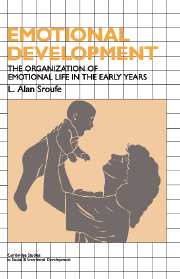Book contents
- Frontmatter
- Contents
- Preface
- Part I The nature of emotional development
- Part II The unfolding of the emotions
- 4 An organizational perspective on the emergence of emotions
- 5 The development of joy: a prototype for the study of emotion
- 6 The development of fear: further illustration of the organizational viewpoint
- 7 The interdependence of affect and cognition
- 8 Meaning, evaluation, and emotion
- Part III Emotional development and individual adaptation
- References
- Index
6 - The development of fear: further illustration of the organizational viewpoint
Published online by Cambridge University Press: 16 September 2009
- Frontmatter
- Contents
- Preface
- Part I The nature of emotional development
- Part II The unfolding of the emotions
- 4 An organizational perspective on the emergence of emotions
- 5 The development of joy: a prototype for the study of emotion
- 6 The development of fear: further illustration of the organizational viewpoint
- 7 The interdependence of affect and cognition
- 8 Meaning, evaluation, and emotion
- Part III Emotional development and individual adaptation
- References
- Index
Summary
What do we mean when we say that the infant is fearful? We mean that there exists a set of behaviors in a particular context that we use to infer that the infant is fearful.
Lewis and Rosenblum (1974)Two stimulus situations that, when present singly, might arouse fear at only a low intensity may, when present together, arouse it at high intensity … the presence … of an attachment figure … makes an immense difference to the intensity of the fear aroused.
Bowlby (1973)The emerging of fear from its predecessors further reveals fundamental processes of development. It illustrates especially well the phenomenon of changing mechanisms underlying related affective reactions as they develop and, in particular, the increasing role of meaning. As was the case with the pleasure/joy system, what I will call fear does not exist in the newborn period and yet develops from precursors in early infancy. Moreover, fear, like other emotions, continues to evolve through the toddler period and beyond, with advances in cognitive development. Rather than thinking of fear as something that suddenly appears at a given age, an organizational viewpoint underscores a developmental sequence of qualitative changes, with fear emerging over the course of infancy along with fundamental changes in the basis for emotional arousal.
- Type
- Chapter
- Information
- Emotional DevelopmentThe Organization of Emotional Life in the Early Years, pp. 101 - 116Publisher: Cambridge University PressPrint publication year: 1996



